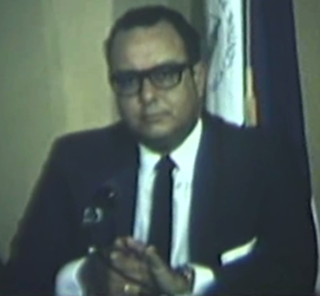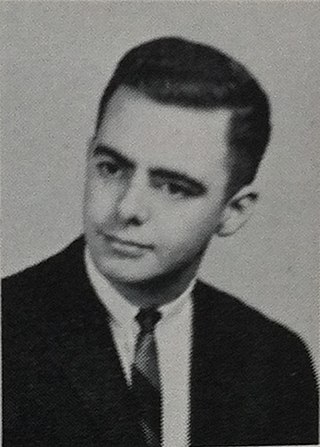Related Research Articles
Nicaragua is a nation in Central America. It is located about midway between Mexico and Colombia, bordered by Honduras to the north and Costa Rica to the south. Nicaragua ranges from the Caribbean Sea on the nation's east coast, and the Pacific Ocean bordering the west. Nicaragua also possesses a series of islands and cays located in the Caribbean Sea.

The Sandinista National Liberation Front is a left-wing political party in Nicaragua. Its members are called Sandinistas in both English and Spanish. The party is named after Augusto César Sandino, who led the Nicaraguan resistance against the United States occupation of Nicaragua in the 1930s.

Anastasio "Tachito" Somoza Debayle was the President of Nicaragua from 1 May 1967 to 1 May 1972 and from 1 December 1974 to 17 July 1979. As head of the National Guard, he was de facto ruler of the country between 1967 and 1979, even during the period when he was not the de jure ruler.

The Somoza family is a political family which ruled Nicaragua for forty-three years – from 1936 to 1979. Their family dictatorship, founded by Anastasio Somoza García, was continued by his two sons Luis Somoza Debayle and Anastasio Somoza Debayle. Anastasio Somoza García served as the President of Nicaragua from 1937 until 1956. He was succeeded by his elder son, Luis Somoza Debayle, who held the presidency from 1957 to 1963. The younger Somoza son, Anastasio Somoza Debayle, had two presidential terms: 1967–1972 and 1974–1979. Although the Somozas did not hold the presidency for the full forty-three years, they continued to rule through puppet presidents and via their control of the National Guard.

Anastasio Somoza García was the leader of Nicaragua from 1937 until his assassination in 1956. He was officially the 21st President of Nicaragua from 1 January 1937 to 1 May 1947 and from 21 May 1950 until his assassination on 29 September 1956, ruling for the rest of the time as an unelected military dictator. He was the patriarch of the Somoza family, which ruled Nicaragua as a family dictatorship for 42 years.

The Nicaraguan Revolution encompassed the rising opposition to the Somoza dictatorship in the 1960s and 1970s, the campaign led by the Sandinista National Liberation Front (FSLN) to oust the dictatorship in 1978–79, the subsequent efforts of the FSLN to govern Nicaragua from 1979 to 1990, and the Contra War, which was waged between the FSLN-led government of Nicaragua and the United States–backed Contras from 1981 to 1990. The revolution marked a significant period in the history of Nicaragua and revealed the country as one of the major proxy war battlegrounds of the Cold War, attracting much international attention.

William D. "Bill" Stewart was an American journalist with ABC News who was murdered by Nicaraguan government National Guard ("Guardia") forces while reporting on the Nicaraguan Revolution as Sandinista rebel forces were closing in on the capital city of Managua in 1979. Footage of his execution was repeatedly broadcast on network television, resulting in an uproar in the United States against the Somoza regime.
Pedro Joaquín Chamorro Cardenal was a Nicaraguan journalist and publisher. He was the editor of La Prensa, the only significant opposition newspaper to the long rule of the Somoza family. He is a 1977 laureate of the Maria Moors Cabot Prize of Columbia University in New York. He married Violeta Barrios de Chamorro, who later went on to become President of Nicaragua (1990–1997). In 1978, he was shot to death, one of the precipitating events of the overthrow of the Somoza regime the following year.
Anastasio Somoza Portocarrero is a Nicaraguan American colonel and businessman.

Francisco Urcuyo Maliaños was a Nicaraguan politician, who served as Vice President of Anastasio Somoza Debayle from 1967 to 1972, and President of Nicaragua very briefly after Somoza fled the country in 1979.

The Junta of National Reconstruction was the provisional government of Nicaragua from the fall of the Somoza dictatorship in July 1979 until January 1985, with the election of Sandinista National Liberation Front’s Daniel Ortega as president.

Miguel Obando y Bravo, SDB was a Nicaraguan prelate of the Catholic Church. He was the Archbishop of Managua from 1970 to 2005. Pope John Paul II created him a cardinal in 1985.
La Prensa is a Nicaraguan newspaper, with offices in the capital Managua. Its current daily circulation is placed at 42,000. Founded in 1926, in 1932 it was bought by Pedro Joaquín Chamorro Zelaya, who had become editor-in-chief. He promoted the Conservative Party of Nicaragua and became a voice of opposition to Juan Bautista Sacasa, for which the paper was censored. He continued to be critical of dictator Anastasio Somoza García, who came to power in a coup d'état.

Arturo José Cruz Porras, sometimes called Arturo Cruz Sr. to distinguish him from his son, was a Nicaraguan banker and technocrat. He became prominent in politics during the Sandinista (FSLN) era. After repeatedly resigning from positions in protest, opinion divided between those who lauded him as a statesman and man of principle, and those who derided him as an ineffectual hand-wringer.
Operation Charly, was allegedly the code-name given to a program during the 1970s and 1980s undertaken by the junta in Argentina with the objective of providing military and counterinsurgency assistance to right-wing dictatorships and insurgents in Central America. According to Noam Chomsky, the operation was either headed by the Argentine military with the agreement of the United States Department of Defense, or was led by the US and used the Argentinians as a proxy.

General elections were held in Nicaragua on 3 February 1957 to elect a president and National Congress.
Luis Somoza Debayle formalized his grip on the presidency through fraudulent elections in February 1957 which were boycotted by all the opposition except the puppet Conservative Nationalist Party (PNC). The Popular Social Christian Party (PPSC) was created in reaction to these elections and received support from younger Conservatives dissatisfied with their party’s inability to make any political impact on the dictatorship.

Constitutional Assembly elections were held in Nicaragua on 6 November 1938.
The elections held on 6 November 1938 were even more of a sham than those that named Anastasio Somoza García president in 1936. The Conservatives decided to abstain again, while the ballot boxes and ballots were distributed throughout the country by the quartermaster general of the Guardia Nacional. The final results were made available within twenty-four hours. In 1938 the Genuino Conservatives decided to field candidates for the Constituent Assembly although the Conservative party’s leadership vehemently opposed the plan.

General elections were held in Nicaragua on 6 November 1932 to elect the president, half of the seats in the Chamber of Deputies and one-third of the seats in the Senate of the National Congress.

General elections were held in Nicaragua on 4 November 1928 to elect a president, half of the deputies and a third of the senators of the National Congress.
Lawrence Anthony Pezzullo was an American diplomat and Foreign Service officer. He served as the United States Ambassador to Nicaragua (1979–1981) and to Uruguay (1977–1979). He was also the executive director of Catholic Relief Services from 1983 to 1992.
References
- ↑ Ballard, Patricia L. (1987). "From Banana Republic to Cattle Republic: Agrarian Roots of the Crisis in Honduras". University of Wisconsin--Madison.
- ↑ "ISLA June 1979". Information Services on Latin America. June 1979.
- ↑ "Foreign Relations of the United States 1977–1980; Volume XV; Central America, 1977–1980 - Office of the Historian". history.state.gov.
- ↑ von Houwald, Götz. "Los alemanes en Nicaragua" (PDF).
- ↑ Times, Alan Riding 'special to The New York (28 June 1979). "Reporter's Notebook: Soinoza Fights On as Aides Worry". The New York Times.
- ↑ Pezzullo, Lawrence; Pezzullo, Ralph (1993). "At the Fall of Somoza". University of Pittsburgh Press.